Bearded dragons make fine pets, but they require special care
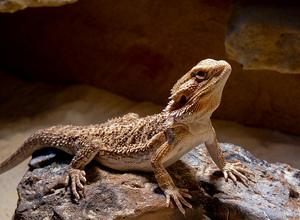
Photo by Flickr user Dennis Hummel
Bearded Dragons are my favorite pet lizards. They are highly interactive and relatively easy to care for. In the wild they live in arid, rocky environments.
A well cared for dragon will live for seven to 10 years. Taking the time to care for them properly can really pay off, as most diseases in dragons can be avoided by practicing good animal husbandry.
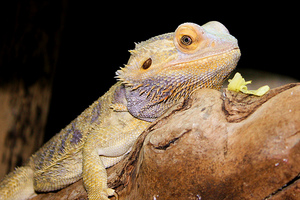
Photo by Flickr user Malikyounas
The beard:
Bearded dragons have a chameleon-like ability to change the color of the skin on their necks to black. Males show off their beards more often than females. The color change can be associated with territorial displays, courtship behaviors, temperature variations or agitation. As a veterinarian, I get to see the beard change colors pretty frequently (it turns out no one likes to go to the doctor).
Housing:
Dragons should be kept in large aquariums (minimum of 72 inches long, 16 inches wide and 17 inches high for a single dragon). Dragons are good climbers, so they should have plenty of wide branches and a wire-top cage (they can, and will, escape if you let them). My favorite cage liner is plain newspaper, paper towel or CareFRESH bedding. Sand can be ingested and cause intestinal impaction, and several other products can be irritating to the skin and lungs. Make sure that your tank has a place for them to bask and a place to hide under.
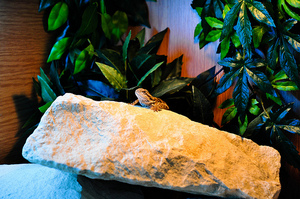
Photo by Flickr user Skenmy
UVB lighting:
Lack of UVB lighting is one of the leading causes of diseases in bearded dragons. Make sure that you purchase a light with “UVB” on it (HINT: it will be a really expensive bulb). These bulbs should be changed every six months regardless of whether or not they are still working. The light should be on for approximately 12 hours per day. I strongly recommend getting an automatic light timer for consistency.
Temperature:
The cage should be kept between 75-80 degrees in the day, with a focal basking spot that reaches 90-100 degrees, and in the low to mid 70s at night. You will need a thermometer to properly monitor the temperature in the cage — take measurements where your dragon actually spends its time. Some UVB lights are also basking lights, but you may need a separate basking lamp. You will also need to get a nighttime heat source (red light, blue light or ceramic heat). Hot rocks are not a good idea, as they have been known to cause burns.
All of these lamps and heaters are potential household hazards, so make sure to get light fixtures that are rated for the wattage of the bulbs, don’t overload your outlets, and keep flammable objects well away from the lamps. Lazy lizard ownership can cause house fires.
Breeding:
Bearded dragons should be kept alone, in breeding pairs or in groups of one male with a few females. Determine the sex of your dragon is by simply taking a peek down below (luckily the internet has pictures to help). Breeding dragons takes a lot of special attention, substrates, heating requirement, etc., so it is definitely not recommended to anyone who isn’t prepared to do serious homework.
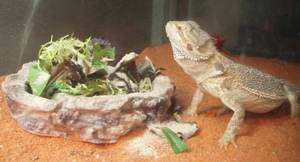
Photo by Flickr user Her Wings
Feeding:
Bearded dragons are omnivorous and rely heavily on plants as adults. They should be offered a choice of greens daily (collard, kale, romaine, mustard, endive, red leaf, green leaf, Boston, parsley, bok choy) and small amounts of select vegetables and fruits (carrot, sweet potato, squash, peas, beans, berries, mango, kiwi, apple, pear, melon). Fruits should make up no more than 10 percent of the diet and should only be offered two or three times per week.
Crickets should be offered two or three times per week as well. All crickets should be gut-loaded (it’s humane to the crickets and healthy for the dragon). Place your crickets in a small, vented container with egg crate or toilet paper rolls. Give them crushed dragon pellets or dog/cat food and a source of water (wet paper towel or electrolyte cubes). After a few days in this deluxe tank, the crickets will be ready for you to feed them to the lizard. Insects can be dusted with a calcium/Vitamin D3 supplement before feeding twice weekly and every other week with a multivitamin that contains vitamin A. Don’t feed your dragon wild-caught insects, because they can carry parasites or be toxic (fireflies can kill your dragon).
If your dragon likes bearded dragon pellets, it’s ok to feed them up to 50 percent of their diet — just moisten pellets and decrease the amount of vitamin/mineral supplementation.
Water:
Bearded dragons should be offered a large, shallow dish of water that they can fit most of their body into. This water should be changed daily. Dragons should be soaked one or two times per week by placing them in high-sided container with chest-deep, lukewarm water for 10-15 minutes. Soaking your dragon promotes drinking, aids in water absorption and helps condition the skin.
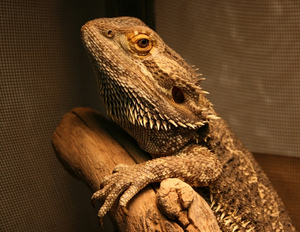
Photo by Flickr user Her Wings
Medical Problems:
Bearded dragons should be seen by a reptile veterinarian annually for a physical and a fecal examination. Common signs of illness are weight loss, not eating/drinking, abnormal poop, twitching, seizures, swelling of limbs, problems closing their mouth, discharge from the eyes or mouth, hard breathing, distended abdomen, masses, wounds or retained skin after shedding. These signs are all indicative of problems that need veterinary attention. Weighing your dragon regularly on a sensitive scale is one of the best ways to pick up on illness early.
Human Health Concerns:
All reptiles can potentially harbor salmonella on their bodies. Wash your hands thoroughly after handling bearded dragons. Also be careful not to contaminate your sinks with materials used in your dragon’s enclosure.
Keeping bearded dragons takes a little commitment, but they give a lot in return!
Dr. Lyssa Alexander treats small and exotic animals and pocket pets at All Creatures Animal Clinic.


Comments
makuro135
Mon, Aug 1, 2011 : 12:53 p.m.
I also have a blog about it and want to share with you. <a href="http://www.beardeddragoncaredr.com" rel='nofollow'>http://www.beardeddragoncaredr.com</a>
makuro135
Mon, Aug 1, 2011 : 12:52 p.m.
I like this animal. I also own one. I feed it everyday and it is my friend. :) Bearded Dragon Care